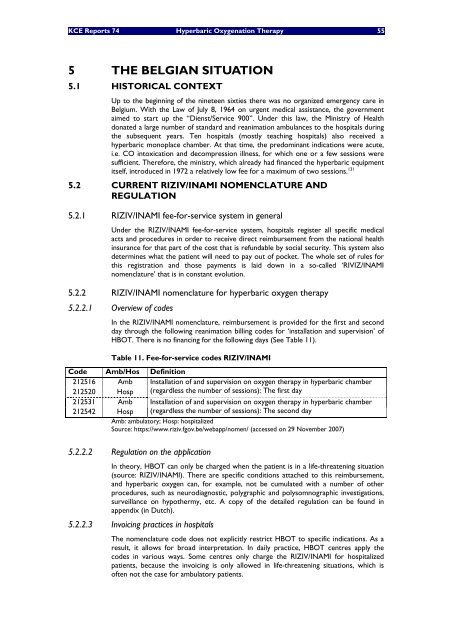Hyperbare Zuurstoftherapie: Rapid Assessment - KCE
Hyperbare Zuurstoftherapie: Rapid Assessment - KCE
Hyperbare Zuurstoftherapie: Rapid Assessment - KCE
Create successful ePaper yourself
Turn your PDF publications into a flip-book with our unique Google optimized e-Paper software.
<strong>KCE</strong> Reports 74 Hyperbaric Oxygenation Therapy 55<br />
5 THE BELGIAN SITUATION<br />
5.1 HISTORICAL CONTEXT<br />
Up to the beginning of the nineteen sixties there was no organized emergency care in<br />
Belgium. With the Law of July 8, 1964 on urgent medical assistance, the government<br />
aimed to start up the “Dienst/Service 900”. Under this law, the Ministry of Health<br />
donated a large number of standard and reanimation ambulances to the hospitals during<br />
the subsequent years. Ten hospitals (mostly teaching hospitals) also received a<br />
hyperbaric monoplace chamber. At that time, the predominant indications were acute,<br />
i.e. CO intoxication and decompression illness, for which one or a few sessions were<br />
sufficient. Therefore, the ministry, which already had financed the hyperbaric equipment<br />
itself, introduced in 1972 a relatively low fee for a maximum of two sessions. 131<br />
5.2 CURRENT RIZIV/INAMI NOMENCLATURE AND<br />
REGULATION<br />
5.2.1 RIZIV/INAMI fee-for-service system in general<br />
Under the RIZIV/INAMI fee-for-service system, hospitals register all specific medical<br />
acts and procedures in order to receive direct reimbursement from the national health<br />
insurance for that part of the cost that is refundable by social security. This system also<br />
determines what the patient will need to pay out of pocket. The whole set of rules for<br />
this registration and those payments is laid down in a so-called ‘RIVIZ/INAMI<br />
nomenclature’ that is in constant evolution.<br />
5.2.2 RIZIV/INAMI nomenclature for hyperbaric oxygen therapy<br />
5.2.2.1 Overview of codes<br />
In the RIZIV/INAMI nomenclature, reimbursement is provided for the first and second<br />
day through the following reanimation billing codes for ‘installation and supervision’ of<br />
HBOT. There is no financing for the following days (See Table 11).<br />
Table 11. Fee-for-service codes RIZIV/INAMI<br />
Code Amb/Hos Definition<br />
212516 Amb Installation of and supervision on oxygen therapy in hyperbaric chamber<br />
212520 Hosp (regardless the number of sessions): The first day<br />
212531 Amb Installation of and supervision on oxygen therapy in hyperbaric chamber<br />
212542 Hosp (regardless the number of sessions): The second day<br />
Amb: ambulatory; Hosp: hospitalized<br />
Source: https://www.riziv.fgov.be/webapp/nomen/ (accessed on 29 November 2007)<br />
5.2.2.2 Regulation on the application<br />
In theory, HBOT can only be charged when the patient is in a life-threatening situation<br />
(source: RIZIV/INAMI). There are specific conditions attached to this reimbursement,<br />
and hyperbaric oxygen can, for example, not be cumulated with a number of other<br />
procedures, such as neurodiagnostic, polygraphic and polysomnographic investigations,<br />
surveillance on hypothermy, etc. A copy of the detailed regulation can be found in<br />
appendix (in Dutch).<br />
5.2.2.3 Invoicing practices in hospitals<br />
The nomenclature code does not explicitly restrict HBOT to specific indications. As a<br />
result, it allows for broad interpretation. In daily practice, HBOT centres apply the<br />
codes in various ways. Some centres only charge the RIZIV/INAMI for hospitalized<br />
patients, because the invoicing is only allowed in life-threatening situations, which is<br />
often not the case for ambulatory patients.

















